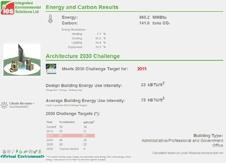IES's free software is suitable for all building types worldwide and it assesses performance against the US 2030 Challenge
Integrated Environmental Solutions (IES) has launched VE-Ware, a free building energy usage and carbon emission calculation software.
The software gives unlimited access to the virtual environment Apache thermal analysis software so that new and existing buildings can have their energy and carbon emissions easily assessed for free.

VE-Ware allows for instant feedback on buildings’ energy consumption and CO² emissions based on real geometry, and using international data on climatic conditions and the typical characteristics of different building, room and system types.
It is ideal for use at early stages as it facilitates iterative design, allowing the comparison of different design, layout and system options.
Additionally in the US, as a direct response to the Architecture 2030 Challenge, VE-Ware will assess how the building is performing against this benchmark.
The data entry and outputs are managed for the user so that anyone can use VE-Ware to help reduce the energy consumption and carbon emissions of a building.
Don McLean, managing director of IES, said: “I expect VE-Ware to make a considerable difference in helping reduce the energy consumption of buildings throughout the world.”
Initially only models exported directly from Autodesk’s world leading Building Information Modelling (BIM) Revit platform can be accepted by VE-Ware. However, over the coming months this will be expanded to include other options for inputting the geometry data.
The goal is to make VE-Ware available globally to anyone who wishes to use it, regardless of vendor or system.
Here’s a step-by-step guide to using IES’s VE-Ware:
Insert geometry data
Tell it where your building is in the world
Define your: building type
construction materials
heating and cooling system types
room types
Press a button – automatic detailed thermal simulation is performed for you
Get output on: energy consumption
CO2 emissions
US benchmark against the 2030 Challenge
You can then easily modify your building and assess different options




























2 Readers' comments